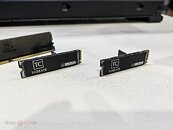- Joined
- Oct 9, 2007
- Messages
- 47,476 (7.50/day)
- Location
- Hyderabad, India
| System Name | RBMK-1000 |
|---|---|
| Processor | AMD Ryzen 7 5700G |
| Motherboard | ASUS ROG Strix B450-E Gaming |
| Cooling | DeepCool Gammax L240 V2 |
| Memory | 2x 8GB G.Skill Sniper X |
| Video Card(s) | Palit GeForce RTX 2080 SUPER GameRock |
| Storage | Western Digital Black NVMe 512GB |
| Display(s) | BenQ 1440p 60 Hz 27-inch |
| Case | Corsair Carbide 100R |
| Audio Device(s) | ASUS SupremeFX S1220A |
| Power Supply | Cooler Master MWE Gold 650W |
| Mouse | ASUS ROG Strix Impact |
| Keyboard | Gamdias Hermes E2 |
| Software | Windows 11 Pro |
M.2-2280 SSDs are always smaller than they look in pictures, a quarter of the size of a DIMM, but we've come across some huge cooling solutions. One of the most interesting of these is the T-Force Dark Airflow 06 magnetic-stacked cooling solution. An extruded aluminium heatsink with its fins positioned sideways, has two flattened surfaces, one of which makes contact with the SSD, the other is equally flat, and can make contact with another such heatsink.
A 20 mm fan pushes airflow sideways through the heatsink. The heatsink is magnetized to help with the stacking. The Dark Airflow 05 is a more conventional fin-stack heatsink that isn't expandable, it uses a simple aluminium fin-stack to which heat is fed by two copper heatpipes. The T-Force GE Pro Gen 5 is an M.2-2280 drive that leads Team Group's gaming SSD lineup. It comes in capacities of up to 4 TB, with transfer speeds of 14 GB/s reads, with up to 11 GB/s writes. The T-Create I54 Ai Gen 5 is not far behind, with a 4 TB, and up to 14 GB/s sequential speeds on tap, with a large amount of SLC caching that should benefit AI workloads.




View at TechPowerUp Main Site
A 20 mm fan pushes airflow sideways through the heatsink. The heatsink is magnetized to help with the stacking. The Dark Airflow 05 is a more conventional fin-stack heatsink that isn't expandable, it uses a simple aluminium fin-stack to which heat is fed by two copper heatpipes. The T-Force GE Pro Gen 5 is an M.2-2280 drive that leads Team Group's gaming SSD lineup. It comes in capacities of up to 4 TB, with transfer speeds of 14 GB/s reads, with up to 11 GB/s writes. The T-Create I54 Ai Gen 5 is not far behind, with a 4 TB, and up to 14 GB/s sequential speeds on tap, with a large amount of SLC caching that should benefit AI workloads.




View at TechPowerUp Main Site


